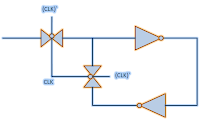What is propagation delay: Propagation delay of a logic gate is defined as the time it takes for the effect of change in input to be visible at the output. In other words, propagation delay is the time required for the input to be propagated to the output. Normally, it is defined as the difference
between the times when the transitioning input reaches 50% of its final value
to the time when the output reaches 50% of the final value showing the effect
of input change. Here, 50% is the defined as the logic threshold where output (or, in particular, any signal) is assumed to switch its states.
 |
| Figure 1: 2-input AND gate |
Propagation delay example: Let us consider a 2-input AND gate as shown in figure 1, with input ‘I2’ making transition from logic ‘0’ to logic ‘1’ and 'I1' being stable at logic value '1'. In effect, it will cause the output ‘O’ also to make a transition. The output will not show the effect immediately, but after certain time interval. The timing diagram for the transitions are also shown. The propagation delay, in this case, will be the time interval between I2 reaching 50% while rising to 'O' reaching 50% mark while rising as a result of 'I2' making a transition. The propagation delay is labeled as “TP” in figure 2.
On what factors propagation delay
depends: The propagation delay of a logic gate is not a constant value,
but is dependent upon two factors:
- Transition time of the input causing transition at the output: More the transition time at the input, more will be the propagation delay of the cell. For less propagation delays, the signals should switch faster.
- The output load being felt by the logic gate: Greater is the capacitive load sitting at the output of the cell, more will be the effort put (time taken) to charge it. Hence, greater is the propagation delay.
How Propagation delay of logic gates is calculated: In physical design tools, there can be following sources of calculation of propagation delay:
Output transition time: The output transition time is also governed by the same two factors as propagation delay. In other words, larger transition time and load increase the transition time of the signal at the output of the logic gate. So, for better transition times, both of these should be less.
Read next : Negative delay- How is it possible
Also read:
- Liberty file: Liberty file contains a lookup table for the each input-to-output path (also called as cell arc) for logic gates as .lib models. The table contains values for different input transition times and output loads corresponding to cell delay. Depending upon the input transition and output load that is present in the design for the logic gate under consideration, physical design tools interpolate between these values and calculate the cell delay.
- SDF file: SDF (Standard Delay Format) is the extracted delay information of a design. The current delay information, as calculated, can be dumped into SDF file. It can, then, be read back. In case SDF is read, delays are not calculated and SDF delays are given precedence.
Output transition time: The output transition time is also governed by the same two factors as propagation delay. In other words, larger transition time and load increase the transition time of the signal at the output of the logic gate. So, for better transition times, both of these should be less.
Read next : Negative delay- How is it possible
Also read:















